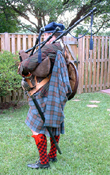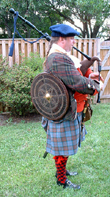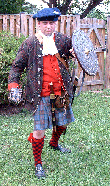Click on the image for the larger version.
This kit represents a typical suit of clothing and arms for a Highland Gael and gentleman piper, c. 1745. The pipes are also turned in a style typical of the period.
 From the white cockade (emblem) on my bonnet, you can infer that I am an Jacobite,
a supporter of the ousted King James II, and follower of his son Prince Charles Edward
Stewart, who came to about 100 miles of London and the overthrow of the Hannoverian
George II before turning back to the Highlands because of bad intel, and being
defeated at Culloden Moor in 1746 during the last land battle to occur on British soil.
From the white cockade (emblem) on my bonnet, you can infer that I am an Jacobite,
a supporter of the ousted King James II, and follower of his son Prince Charles Edward
Stewart, who came to about 100 miles of London and the overthrow of the Hannoverian
George II before turning back to the Highlands because of bad intel, and being
defeated at Culloden Moor in 1746 during the last land battle to occur on British soil. A piper from my period would have been a gentleman of the clan, employed in an
often hereditary position by a clan chief. He would have even had his own servant
(ghille). His native tongue would be Gaelic, and he if he also spoke English, it
would have been with an accent that sounded Irish; as opposed to the Scots tongue.
As the clan piper, he would have trained in his craft for many years, and would
likely have been despatched to study on the Isle of Skye at the famous MacCrimmon
school. There's a good chance that he (like the reenactor himself) would have been
a fiddler as well as a piper, and may even have had continental violin training.
On pipes, the music he played would have consisted of dance tunes (reels and jigs,
possibly strathspeys if he were in the avant-garde), and slow complex airs called
ceol mor. The former would be played at festive occasions, the latter at formal
occasions. On fiddle, he would have played the full gamut of Scottish dance tunes,
as well as slow airs.
A piper from my period would have been a gentleman of the clan, employed in an
often hereditary position by a clan chief. He would have even had his own servant
(ghille). His native tongue would be Gaelic, and he if he also spoke English, it
would have been with an accent that sounded Irish; as opposed to the Scots tongue.
As the clan piper, he would have trained in his craft for many years, and would
likely have been despatched to study on the Isle of Skye at the famous MacCrimmon
school. There's a good chance that he (like the reenactor himself) would have been
a fiddler as well as a piper, and may even have had continental violin training.
On pipes, the music he played would have consisted of dance tunes (reels and jigs,
possibly strathspeys if he were in the avant-garde), and slow complex airs called
ceol mor. The former would be played at festive occasions, the latter at formal
occasions. On fiddle, he would have played the full gamut of Scottish dance tunes,
as well as slow airs. There are three basic articles of clothing worn by the Highlandman of the 18th
century. The first is a knee-length linen shirt with a band or a small fall collar
fastened by a single button at the neck. Secondly, there is the plaid, or breacan
feile, 3 to 7 yards of tartan fabric made from two single-wide (~30") pieces stitched
lengthwise, which was pleated on the ground and belted to the waist, with the upper
half frequently pinned to the shoulder. The tartan he wore was dependant only on what
he could afford, and what the local weaver produced - but sometimes, if in the service
of a powerful chief, he might have been dressed in a livery tartan. In my case, I'm
wearing a 7 yard plaid folded in half lengthwise to make it more managable. If I were
standing for a portrait, I might have pleated the whole length. Lastly, all Highlandmen
would wear a blue knitted wool bonnet. Portraying a wealthier Highlander, I am wearing
tartan hose held in place by garters made of wool tape, and buckle shoes. Most Highlanders
went barefoot except in the worst frost, when they wore moccassains (or currans) made of
raw red deer hide, with the hair side out. I am also wearing a wool waistcoat and jacket,
both of which are lined with linen. There was rarely any desire to match tartans in one
outfit, and one frequently sees paintings of Highlanders with different tartans for the
plaid, hose, waistcoat, and jacket. I also wear a cravat of the finest linen with lace
trim, as befits my station. A man of less means would simply wear a neckcloth. As the
plaid has no pockets as such, I wear a belt pouch, or sporran of leather - sometimes
(not shown here) with a hinged brass top called a cantle.
There are three basic articles of clothing worn by the Highlandman of the 18th
century. The first is a knee-length linen shirt with a band or a small fall collar
fastened by a single button at the neck. Secondly, there is the plaid, or breacan
feile, 3 to 7 yards of tartan fabric made from two single-wide (~30") pieces stitched
lengthwise, which was pleated on the ground and belted to the waist, with the upper
half frequently pinned to the shoulder. The tartan he wore was dependant only on what
he could afford, and what the local weaver produced - but sometimes, if in the service
of a powerful chief, he might have been dressed in a livery tartan. In my case, I'm
wearing a 7 yard plaid folded in half lengthwise to make it more managable. If I were
standing for a portrait, I might have pleated the whole length. Lastly, all Highlandmen
would wear a blue knitted wool bonnet. Portraying a wealthier Highlander, I am wearing
tartan hose held in place by garters made of wool tape, and buckle shoes. Most Highlanders
went barefoot except in the worst frost, when they wore moccassains (or currans) made of
raw red deer hide, with the hair side out. I am also wearing a wool waistcoat and jacket,
both of which are lined with linen. There was rarely any desire to match tartans in one
outfit, and one frequently sees paintings of Highlanders with different tartans for the
plaid, hose, waistcoat, and jacket. I also wear a cravat of the finest linen with lace
trim, as befits my station. A man of less means would simply wear a neckcloth. As the
plaid has no pockets as such, I wear a belt pouch, or sporran of leather - sometimes
(not shown here) with a hinged brass top called a cantle. 
 The arms of a Highlandman of the station I'm portraying are essentially little
different than those of the renaissance; and unlike in the rest of Britain, he would
have worn his arms even in peacetime. His main weapon would be his sword, a basket-hilted
broadsword called a claidheamh mor, complemented by a wooden shield called a targe. The
shield might have a spike on it, more for deflecting an opponent's blade or bayonet than
as a weapon in its own right. He would have also carried a 12" fighting kinfe called a dirk
(sometimes with a smaller utility knife and fork in the scabbard), and if he was wealthy
enough, a steel-framed .50 caliber flintlock pistol (right). Not shown is his firelock musket,
usually a hunting piece, most likely a flintlock, but possibly even an old snaphaunce.
The arms of a Highlandman of the station I'm portraying are essentially little
different than those of the renaissance; and unlike in the rest of Britain, he would
have worn his arms even in peacetime. His main weapon would be his sword, a basket-hilted
broadsword called a claidheamh mor, complemented by a wooden shield called a targe. The
shield might have a spike on it, more for deflecting an opponent's blade or bayonet than
as a weapon in its own right. He would have also carried a 12" fighting kinfe called a dirk
(sometimes with a smaller utility knife and fork in the scabbard), and if he was wealthy
enough, a steel-framed .50 caliber flintlock pistol (right). Not shown is his firelock musket,
usually a hunting piece, most likely a flintlock, but possibly even an old snaphaunce.The pipes of this period differ from the modern in several ways. They would have been most likely to have been made of local woods, like pear, alder, or whitethorn, as opposed to exotic tropical hardwoods - though ebony sets were beginning to appear in this period. The mounts would have been a contrasting wood, or horn. The pipes would have been plain-turned, without the elaborate beading and combing of modern pipes, and the drone tops would have been chalice- or goblet-shaped. The bag would have been simple leather, uncovered by cloth. And the whole pitch of the instrument would have been noticably lower.
What's wrong with this picture?
Every reenactor will also admit the things his kit that are less than perfect. I'm modifying things as fast as I can to get them more accurate. So here goes. The problems with the pipes are twofold. Firstly, the pipes are made of delrin resin - a cheap and durable stopgap. Eventually I will buy a set in whitethorn, but these are running $5k right now, so I'm in no hurry. The bag is glued cowhide with a Gannaway logo on it. When this bag wears out, I'm going going to replace it wth a stitched unbranded cowhide bag. The biggest problem is the coat. This is a coat to be worn with a kilt (feilidh beag), not a belted plaid (breacan feile), and as such is substantially too long. A more correct coat would go no further than the second button from the bottom on the one I'm wearing, so that a bit of the waistcoat shows underneath. This coat and waistcoat are loaners - my own waistcoat and coat are currently being made by a friend. For someone of my station, the sporran should have a hinged brass cantle, and I have one currently on order. There are some flaws in the weapons, too. The basket on the claymore is larger than is accurate for this period, and its scabbard should be leather, not leather-covered wood. The dirk handle is a bit off - the handle should be carved with Celtic knotwork, and have a simple brass pommel with a aquare steel nut. I'll be making the dirk modifications soon. The pistol needs a touch-hole drilled in it; as it stands, it's a display weapon, not a firing one.
The page background is the tartan for County
Londonderry, Ireland. The pattern was developed for Irish expatriates by the House of
Edgar. I have picked it because I am decended* from one George
Walker D.D. (1645-1690), Rictor of Donaghmore, County Londonderry, governor of
Derry during the siege of 1689, and killed in the Battle
of Boyne while acting as the Colonel of the Derry
and Inniskillen Regiments. This branch of Walkers lived in Co.
Londonderry, Ireland from about 1570, having come from Ruddington, Nottingham,
England. His descendants emigrated in 1720 to Appoquinemink
Hundred, Delaware.
* From what genealogical data I've been able to uncover; it gets less certain before the ancestor who fought in the American Revolution.
* From what genealogical data I've been able to uncover; it gets less certain before the ancestor who fought in the American Revolution.
Made on a Mac.
Last Updated 10 January 2006, 11:39 AM ET